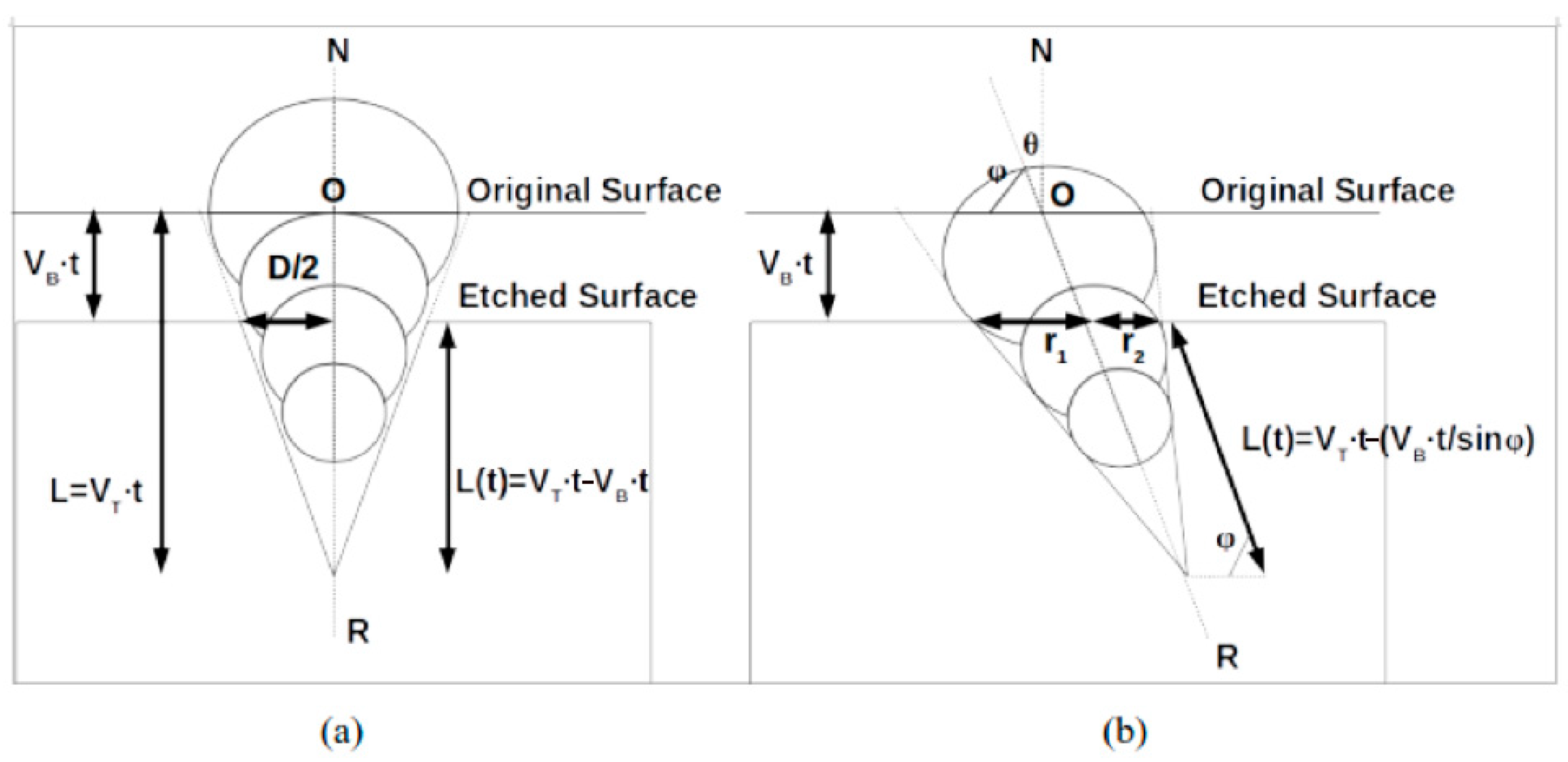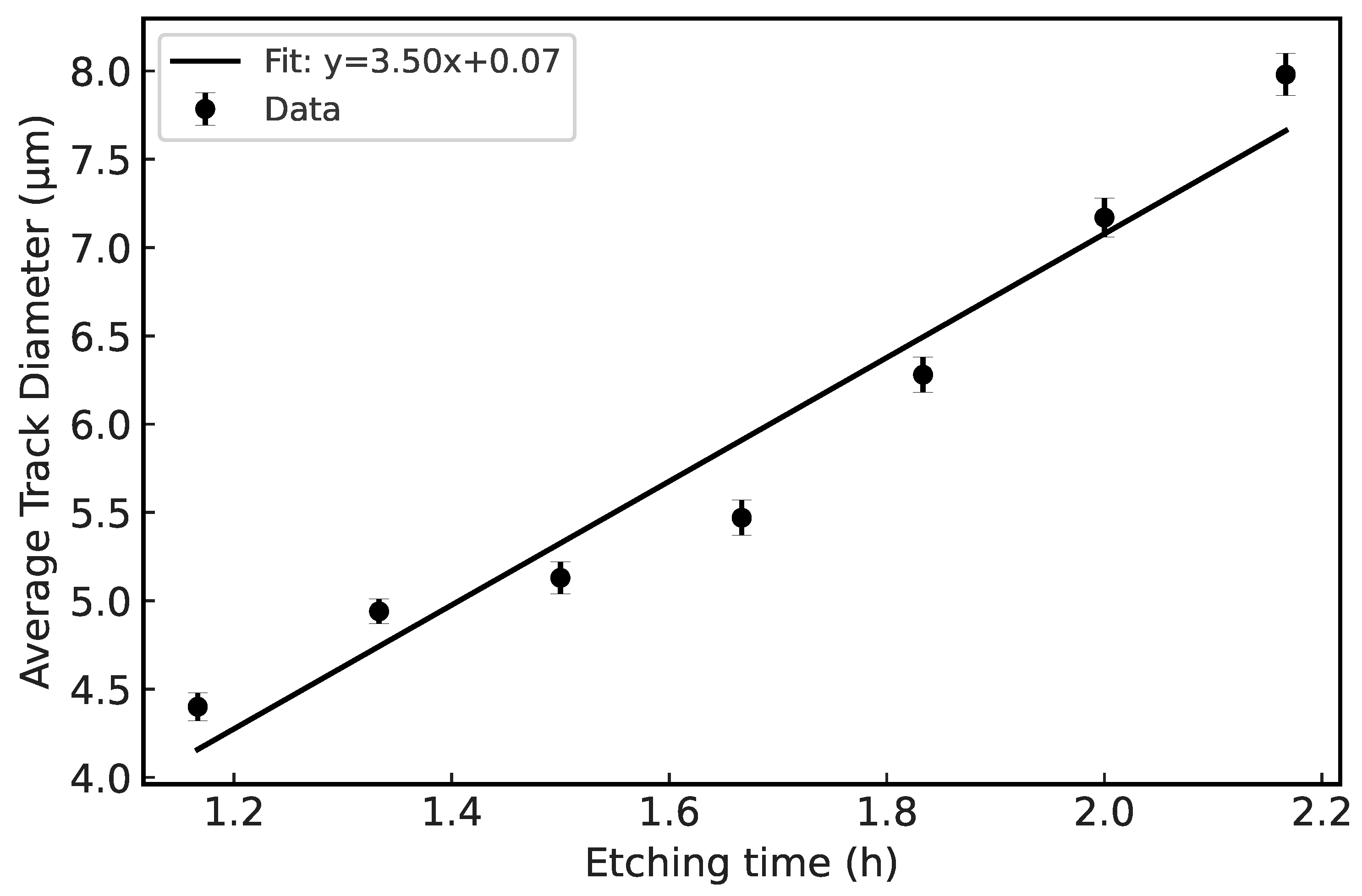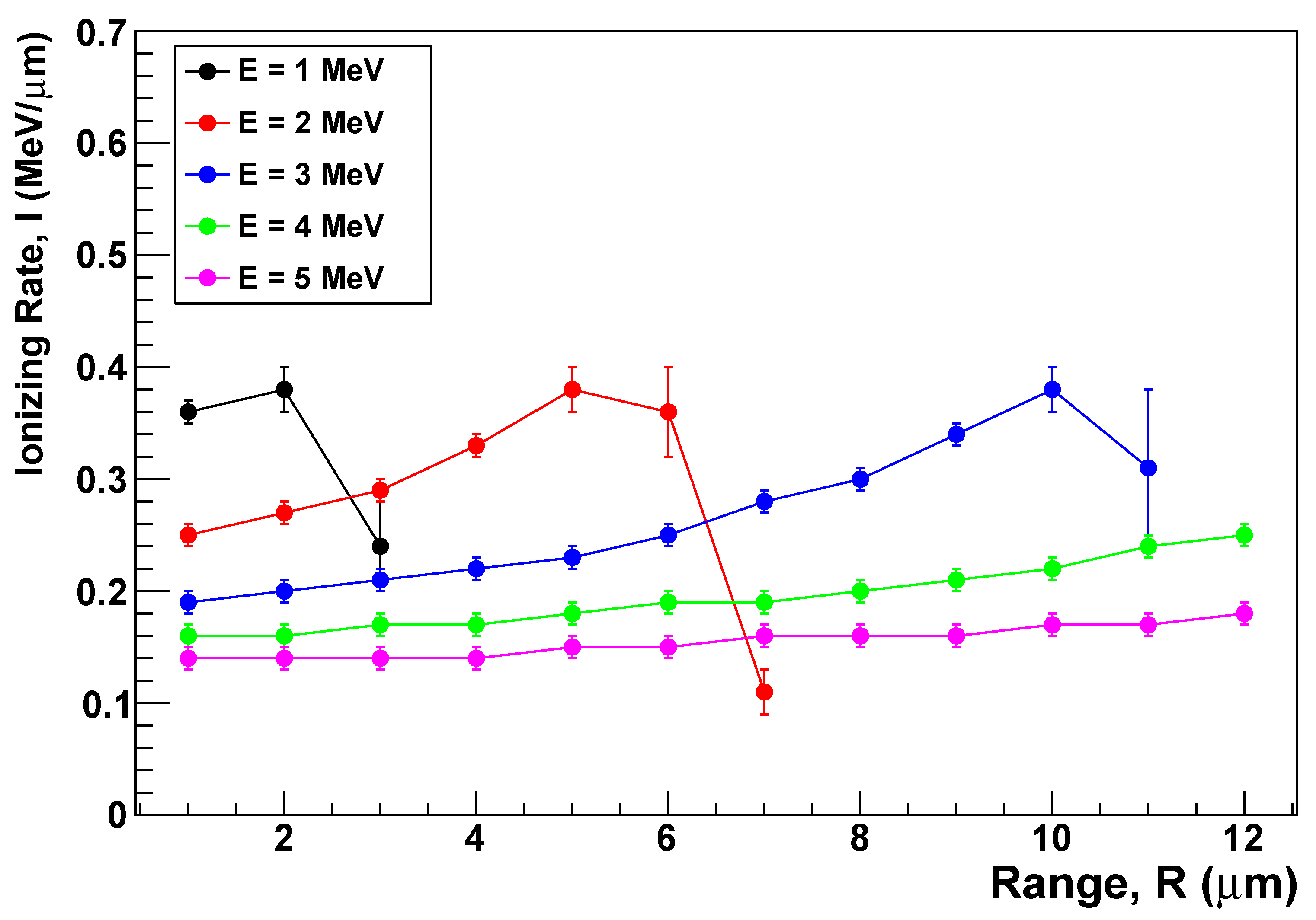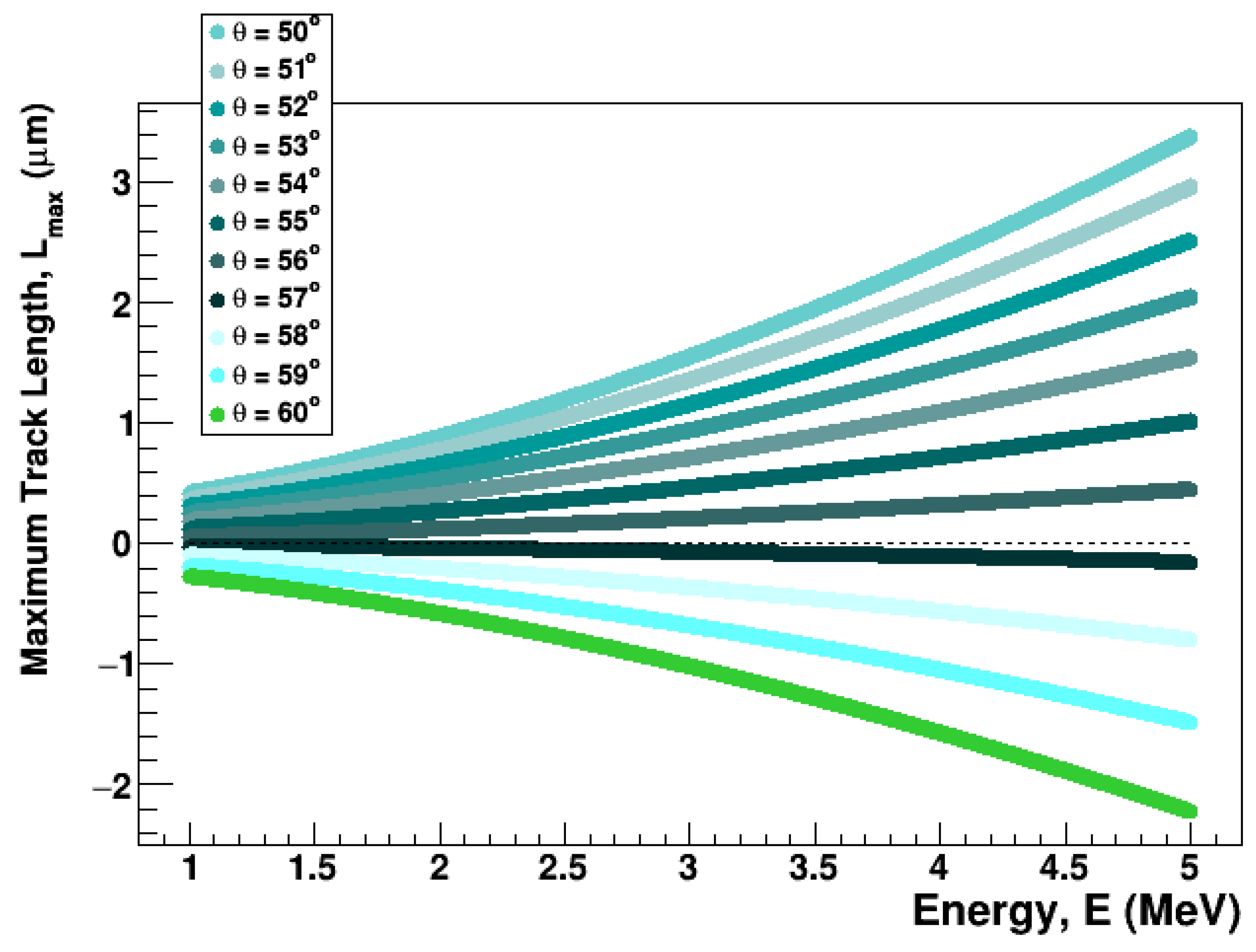Characterization of Alpha Particle Track Lengths in LR-115 Detectors
Abstract
1. Introduction
2. Analytical Procedure
2.1. Experimental Approach
2.2. Monte Carlo Simulation Strategy
3. Results and Discussion
3.1. Etched Track Analysis of Alpha Particles in LR-115 Detector
3.2. Numerical Modeling of LR-115 Detector Response to Alpha Particles
4. Conclusions
Author Contributions
Funding
Data Availability Statement
Conflicts of Interest
References
- Fleischer, R.L.; Price, P.B.; Walker, R.M. Nuclear Tracks in Solids: Principles and Applications; University of California Press: Berkeley, CA, USA, 1975; Available online: https://archive.org/details/bub_gb_yfTBvben3GoC (accessed on 18 October 2025).
- Durrani, S.A.; Bull, R.K. Solid State Nuclear Track Detection: Principles, Methods and Applications; Pergamon Press Ltd.: Oxford, UK; Elsevier Ltd.: Oxford, UK, 1987. [Google Scholar] [CrossRef]
- Nikezic, D.; Yu, K.N. Formation and growth of tracks in nuclear track materials. Mater. Sci. Engin. R Rep. 2004, 46, 51–123. [Google Scholar] [CrossRef]
- Tommasino, L. Detectors/dosemeters of galactic and solar cosmic rays. Radiat. Protect. Dosim. 2004, 109, 365–374. [Google Scholar] [CrossRef]
- Zhou, D.; O’Sullivan, D.; Semones, E.; Zapp, N.; Benton, E.R. Research on sensitivity fading of CR-39 detectors during long time exposure. Radiat. Meas. 2009, 44, 909–912. [Google Scholar] [CrossRef]
- Kumar, A.; Walia, V.; Mogili, S.; Fu, C.-C. Improved semi automatic approach to count the tracks on LR-115 film for monitoring of radioactive elements. Appl. Radiat. Isotop. 2021, 176, 109863. [Google Scholar] [CrossRef]
- Charlesby, A. Atomic Radiation and Polymers; Pergamon Press Ltd.: Oxford, UK; Elsevier Ltd.: Oxford, UK, 1960. [Google Scholar] [CrossRef]
- Hassan, N.M.; Hafez, A.F. Studying the physical parameters of a solid state nuclear track detector. J. Korean Phys. Soc. 2013, 63, 1713–1719. [Google Scholar] [CrossRef]
- Yerimbetova, D.S.; Kozlovskiy, A.L.; Tuichiyev, U.N.; Zhumadilov, K.S. Study of the sensitivity limit of detection of α-particles by polymer film detectors LR-115 type 2 using X-ray diffraction and UV-Vis spectroscopic methods. Polymers 2023, 15, 2500. [Google Scholar] [CrossRef] [PubMed]
- Pereyra, P.; Guevara-Pillaca, C.J.; Liza, R.; Pérez, B.; Rojas, J.; Vilcapoma, L.L.; Gonzales, S.; Sajo-Bohus, L.; López-Herrera, M.E.; Palacios Fernández, D. Estimation of indoor 222Rn concentration in Lima, Peru using LR-115 nuclear track detectors exposed in different modes. Atmosphere 2023, 14, 952. [Google Scholar] [CrossRef]
- La Verde, G.; Ambrosino, F.; Ragosta, M.; Pugliese, M. Results of indoor radon measurements in Campania schools carried out by students of an Italian outreach project. Appl. Sci. 2023, 13, 4701. [Google Scholar] [CrossRef]
- Pressyanov, D.; Dimitrov, D. Fine-scale spatial distribution of indoor radon and identification of potential ingress pathways. Atmosphere 2025, 16, 943. [Google Scholar] [CrossRef]
- Agostinelli, S.; Allison, J.; Amako, K.; Apostolakis, J.; Araujo, H.; Arce, P.; Asai, M.; Axen, D.; Banerjee, S.; Barrand, G.; et al. [Geant4 Collaboration] Geant4 —A simulation toolkit. Nucl. Instrum. Meth. Phys. Res. A Accel. Spectrom. Detect. Assoc. Equip. 2003, 506, 250–303. [Google Scholar] [CrossRef]
- Allison, J.; Amako, K.; Apostolakis, J.; Arce, P.; Asai, M.; Aso, T.; Bagli, E.; Bagulya, A.; Banerjee, S.; Barrand, G.; et al. Recent developments in Geant4. Nucl. Instrum. Meth. Phys. Res. A Accel. Spectrom. Detect. Assoc. Equip. 2016, 835, 186–225. [Google Scholar] [CrossRef]
- Mheemeed, A.K.; Hussein, A.K.; Kheder, R.B. Characterization of alpha-particle tracks in cellulose nitrate LR-115 detectors at various incident energies and angles. Appl. Radiat. Isotop. 2013, 79, 48–55. [Google Scholar] [CrossRef] [PubMed]
- Al-Jubbori, M.A. Empirical model of alpha particle track length in CR-39 detector. Nucl. Instrum. Meth. Phys. Res. A Accel. Spectrom. Detect. Assoc. Equip. 2017, 871, 54–58. [Google Scholar] [CrossRef]
- Tripathy, S.P.; Kolekar, R.V.; Sunil, C.; Sarkar, P.K.; Dwivedi, K.K.; Sharma, D.N. Microwave-induced chemical etching (MCE): A fast etching technique for the solid polymeric track detectors (SPTD). Nucl. Instrum. Meth. Phys. Res. A Accel. Spectrom. Detect. Assoc. Equip. 2010, 612, 421–426. [Google Scholar] [CrossRef]
- Barillon, R.; Fromm, M.; Chambaudet, A.; Marah, H.; Sabir, A. Track etch velocity study in a radon detector (LR 115, cellulose nitrate). Radiat. Meas. 1997, 28, 619–628. [Google Scholar] [CrossRef]
- Stuani Pereira, L.A.; Candido de Azevedo, M.; Nakasuga, W.M.; Figueroa, P.; Tello Sáenz, C.A. Fission-track evolution in Macusanite volcanic glass. Radiat. Phys. Chem. 2020, 176, 109076. [Google Scholar] [CrossRef]
- Media Cybernetics. Image-Pro Plus, Version 4.5. Media Cybernetics, Inc.: Rockville, Maryland, USA, 2003. Available online: https://web.archive.org/web/20031205083627/http://www.mediacy.com/ (accessed on 18 October 2025).
- Hermsdorf, D.; Hunger, M. Determination of track etch rates from wall profiles of particle tracks etched in direct and reversed direction in PADC CR-39 SSNTDs. Radiat. Meas. 2009, 44, 766–774. [Google Scholar] [CrossRef]
- Al-Nia’emi, S.H. A new treatment to compute the track parameters in PADC detector using track opening measurement. J. Phys. Sci. 2018, 29, 89–112. [Google Scholar] [CrossRef]
- Stuani Pereira, L.A.; Tello Sáenz, C.A. Quadratic parametrization of the maximum alpha track lengths in CR-39 detector for various energies and incident angles. Appl. Radiat. Isotop. 2025, 225, 111972. [Google Scholar] [CrossRef]
- Hussain, A.K. Variation of bulk etch rate and some other etching parameters with etching temperature for cellulose nitrate LR-115 detector. J. Educ. Sci. 2009, 22, 49–60. [Google Scholar] [CrossRef]
- Qi, M.; Yang, Q.; Chen, X.; Duan, J.; Yang, L. Fast calculation of Mont Carlo ion transport code. J. Phys. Conf. Ser. 2021, 1739, 012030. [Google Scholar] [CrossRef]









| Incident Angle | ||||
|---|---|---|---|---|
| 0° | 0.270 ± 0.003 | 0.7000 ± 0.0002 | 0.27 ± 0.00004 | 0.9997 |
| 10° | 0.270 ± 0.003 | 0.6900 ± 0.0002 | 0.26 ± 0.00004 | 0.9997 |
| 20° | 0.250 ± 0.003 | 0.6500 ± 0.0002 | 0.25 ± 0.00004 | 0.9997 |
| 30° | 0.220 ± 0.003 | 0.5700 ± 0.0002 | 0.22 ± 0.00004 | 0.9997 |
| 40° | 0.1700 ± 0.0002 | 0.4400 ± 0.0001 | 0.17 ± 0.00002 | 0.9997 |
| 50° | 0.0900 ± 0.0001 | 0.2300 ± 0.0001 | 0.09 ± 0.00001 | 0.9997 |
| 60° | −0.0600 ± 0.0001 | −0.1500 ± 0.00005 | −0.06 ± 0.00001 | 0.9997 |
| 70° | −0.3600 ± 0.0004 | −0.9400 ± 0.0003 | −0.36 ± 0.00005 | 0.9997 |
| Incident Angle | Energy Threshold (MeV) |
|---|---|
| 0° | 3.260 ± 0.005 |
| 10° | 3.290 ± 0.005 |
| 20° | 3.400 ± 0.006 |
| 30° | 3.730 ± 0.006 |
| 40° | 3.900 ± 0.006 |
| 50° | 4.360 ± 0.007 |
| 60° | — |
| 70° | — |
Disclaimer/Publisher’s Note: The statements, opinions and data contained in all publications are solely those of the individual author(s) and contributor(s) and not of MDPI and/or the editor(s). MDPI and/or the editor(s) disclaim responsibility for any injury to people or property resulting from any ideas, methods, instructions or products referred to in the content. |
© 2025 by the authors. Licensee MDPI, Basel, Switzerland. This article is an open access article distributed under the terms and conditions of the Creative Commons Attribution (CC BY) license (https://creativecommons.org/licenses/by/4.0/).
Share and Cite
Stuani Pereira, L.A.; Tello Sáenz, C.A. Characterization of Alpha Particle Track Lengths in LR-115 Detectors. Physics 2025, 7, 56. https://doi.org/10.3390/physics7040056
Stuani Pereira LA, Tello Sáenz CA. Characterization of Alpha Particle Track Lengths in LR-115 Detectors. Physics. 2025; 7(4):56. https://doi.org/10.3390/physics7040056
Chicago/Turabian StyleStuani Pereira, Luiz Augusto, and Carlos Alberto Tello Sáenz. 2025. "Characterization of Alpha Particle Track Lengths in LR-115 Detectors" Physics 7, no. 4: 56. https://doi.org/10.3390/physics7040056
APA StyleStuani Pereira, L. A., & Tello Sáenz, C. A. (2025). Characterization of Alpha Particle Track Lengths in LR-115 Detectors. Physics, 7(4), 56. https://doi.org/10.3390/physics7040056






